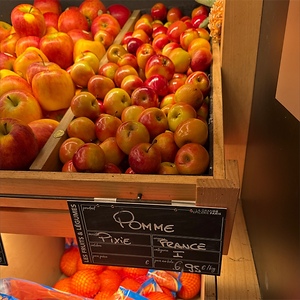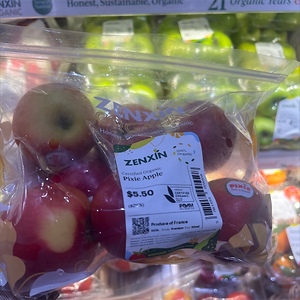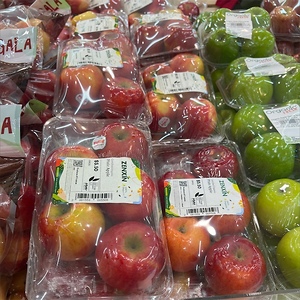


Pixie Apples
Estimated Inventory, lb : 0
Description/Taste
Pixie apples are, like their name suggests, very small. They are also very similar to Cox’s Orange Pippin, one of Pixie’s parents. Pixie apples have some russeting, with a green-yellow skin overlaid with orange or red stripes. The flesh is juicy and crisp and very aromatic. The flavor is similar to Cox’s Orange Pippin— sweet while still tart, but sharp rather than acidic. The flavor develops in storage, becoming less tart over time.
Seasons/Availability
Pixie apples are available in mid-fall through winter.
Current Facts
Pixie apples are a late season variety of Malus domestica that is thought to be a seedling of the popular English Cox’s Orange Pippin crossed with Sunset. The trees are very easy to grow and remain small, so they are good option for small gardens. The Pixie apple should not be confused with another variety called Pixie Crunch.
Nutritional Value
While apples are fat-free, sodium free, and cholesterol free, they are good sources of several other nutrients. They contain small amounts of Vitamin B, boron, and quercetin, and larger amounts of Vitamin C and dietary fiber. The antioxidants and phytochemicals in apples help support holistic health, and may prevent chronic diseases such as diabetes, cancer, and heart disease.
Applications
Pixie apples are primarily a dessert variety, to be eaten fresh out of hand. Use in salads, pair with an English cheddar, or use in recipes calling for Cox’s Orange Pippins. They are good keepers, and can be kept for three months or more in proper cool, dry storage conditions.
Ethnic/Cultural Info
Grocery stores tend to carry only certain varieties of apples that are easy to ship, large, and uniform in size. Pixies are too small to be found in most grocery stores, although they have an excellent texture and flavor. They are more likely to be found in home gardeners’ yards.
Geography/History
The Pixie apple was developed at the National Fruit Trials farm in Kent, England. The first Pixie seedling was discovered in 1947. After several years of development, they received the Royal Horticultural Society’s Award of Merit in 1970. Pixie apple trees grow in temperate climates with plenty of rain, such as England.
Recipe Ideas
Recipes that include Pixie Apples. One











